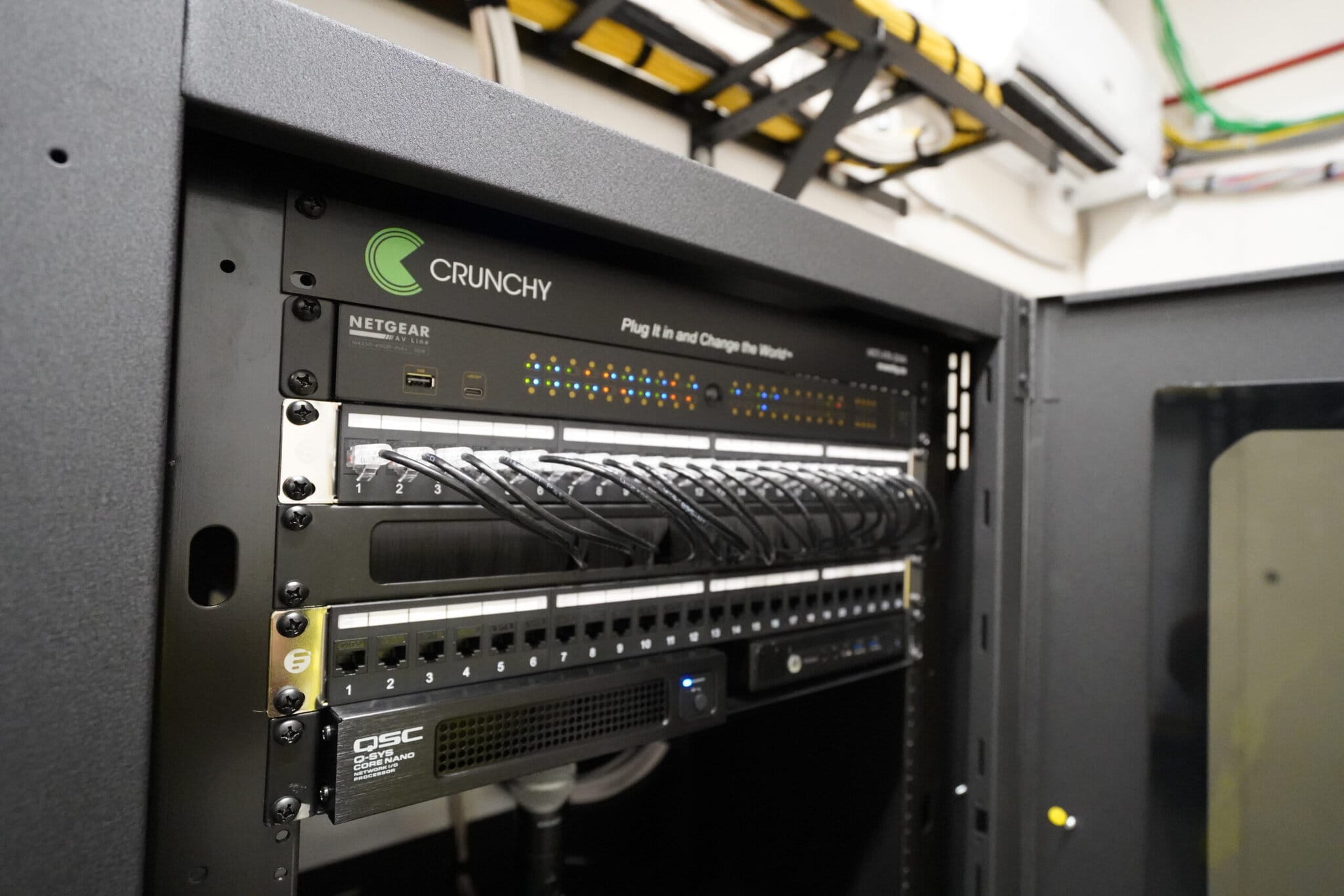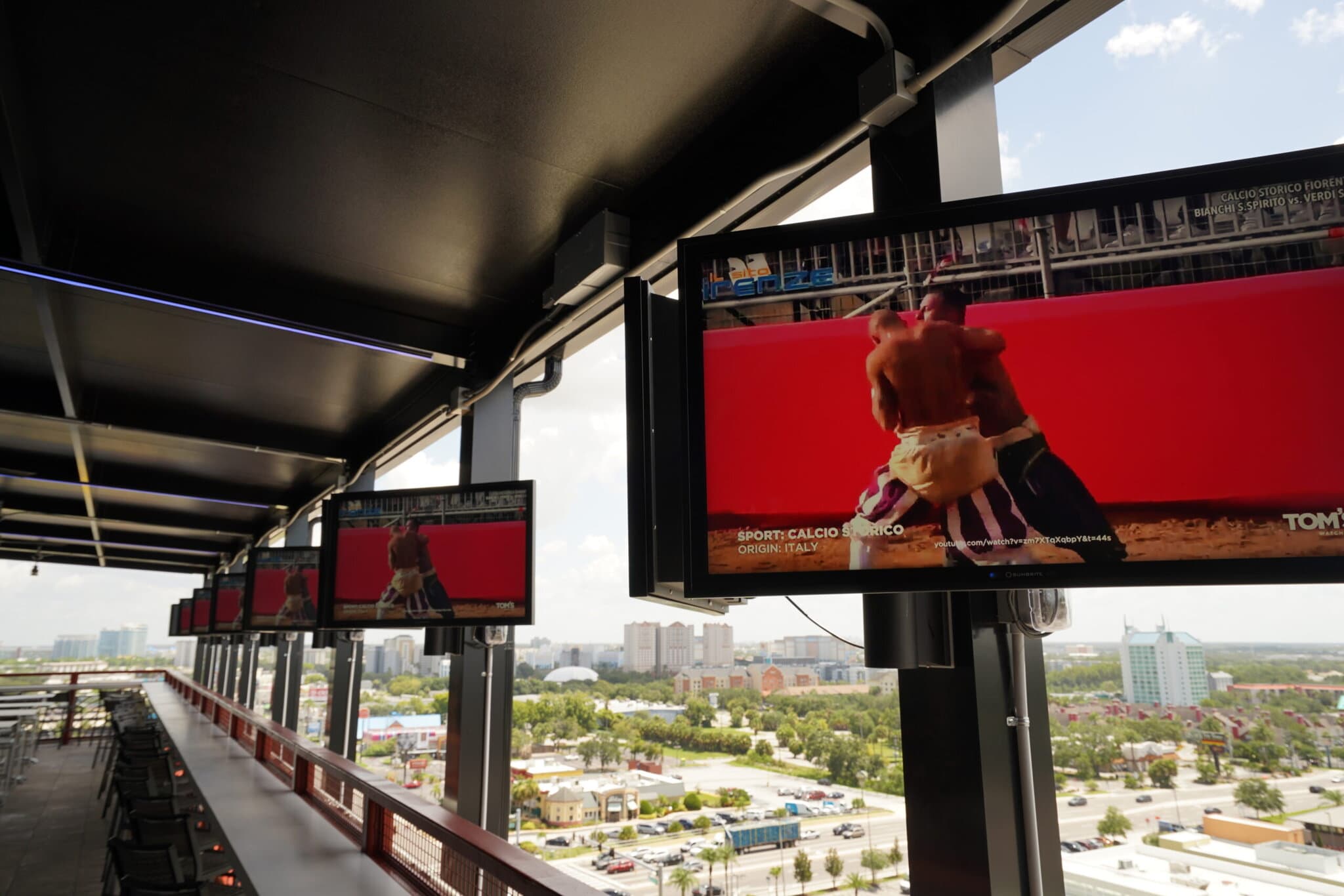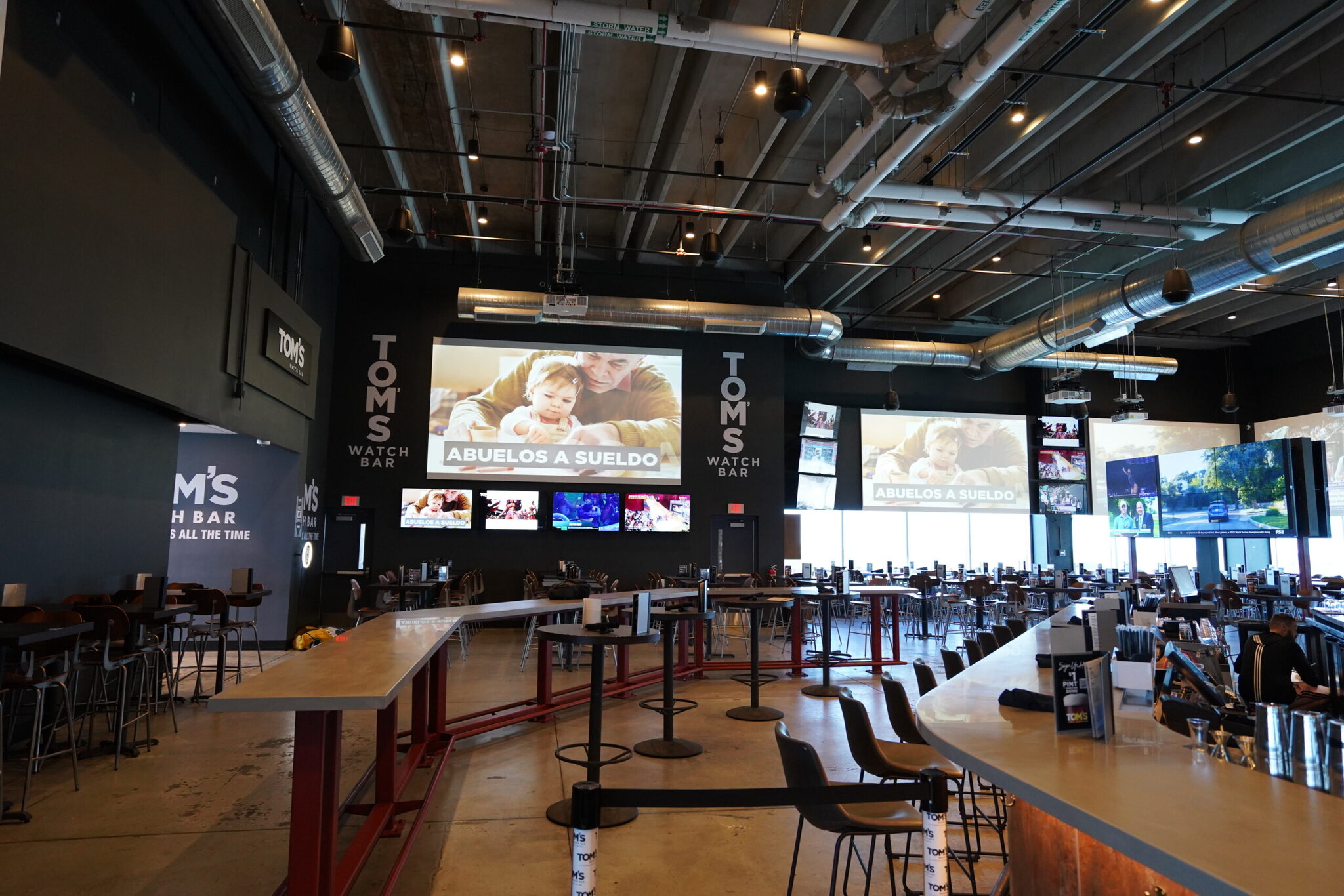Running a sports bar is hectic enough. You shouldn’t have to wrestle with remotes, mismatched audio, or malfunctioning lights. A solid sports bar control system installation fixes that, wherein your screens switch to the right game when they should, the audio plays in the right zone, lights dim (or brighten) with a tap. Everything just satisfactorily works.
This guide walks you through how Crunchy Tech installs your system from the first walkthrough to the final testing phase. You’ll see how we design for your space, handle the setup, and make sure everything operates smoothly before we hand it off. If you’re preparing for an install, this is all you need to know before, during, and after the job.
Pre-Installation Planning
Before any hardware shows up, planning is imperative. Rushing past this stage is how you end up with surprise delays and systems that fall apart under pressure. This is how every Crunchy Tech install starts off on the right foot, with a game plan that actually holds up when the bar is packed.

Site Assessment
Every location is different, which is why we always start with an in-person walkthrough. We plot out where the screens will go, how the speakers should be spaced, where lighting controls make the most sense, and how digital signage fits into the layout.
We also factor in ceiling height, wall types, outlet locations, and how guests move through the space. Because installing around the real world is very different from designing on paper.
Network Infrastructure
Your system runs on your network, so it needs to be fast, secure, and built for the load. That means:
- using business-grade switches and routers
- organizing racks for clean airflow and easy access
- making certain your bandwidth can handle HD video streams, audio control, and live updates to signage all at the same time
- spotting and solving issues like weak Wi-Fi coverage or outdated equipment before they become a problem.
Power & Connectivity
The system won’t run without the right power and wiring. We check that you’ve got enough dedicated circuits in key zones, use surge protection to protect your investment, and plan for cable runs (not ones that trip people up or get pinched in tight corners).
We route everything from HDMI and Cat6 to speaker wire and control cables with future maintenance in mind. And YES! Everything is labeled and documented for easy reference later.
Signal Distribution
We look at your system as one big connected pipeline. From the source, e.g., a cable box, digital signage player, or streaming device, all the way to the TV on the wall or the speaker in the ceiling, every part of the signal path is mapped out. We match the tech (matrix switchers, video-over-IP, audio DSPs, etc.) to your layout so switching between games or zones is fast and stable.
Zone Mapping
Defining your zones is one of the most important steps. We break the space into logical sections—like main bar, patio, booths, or VIP areas—and assign control to each one. That way your staff can manage volume, lighting, and visuals by area instead of scrambling to figure out what’s connected to what. Zones make the system usable, especially when things get real busy.
Existing Equipment Compatibility
Do you already have some gear in place? We won’t ask you to replace it just for the sake of newness. Our team checks what you’ve got—TVs, amps, wiring, you name it—and evaluates whether it can integrate into the new system. If it’s compatible and reliable, we’ll make it work. If it’s going to cause problems later, you’ll get options.
Staff Involvement
Your bartenders and managers know your space better than anyone. That’s why we like to bring them into the planning process early. They can point out blind spots, high-traffic areas, and event-specific needs we wouldn’t see on our own. That input helps us design a system that not just work on a spec sheet but in real life.
Timeline Development
We build a realistic schedule with your team. That includes ordering gear, scheduling any electrical or network upgrades, blocking off install days, and carving out time for testing and staff training. We do our best to time things around your slow periods to avoid disrupting service. The goal is a smooth rollout with no surprises.
Hardware Installation Process
It’s time to roll up our sleeves and start putting your system set up with precision. A crooked mount or a mislabeled cable might not seem like a big deal now, but it can cause major worries down the line. Here’s how we handle the hardware install.

Control Hub Placement
Your system needs a brain and that lives in a protected, centralized rack. We typically install it in a back office or utility closet where it’s out of sight but still accessible. Inside you’ll find your processors, network switches, audio DSPs, and control modules; all mounted with proper airflow and clean cable routing in mind.
We make sure there’s room to expand and nothing overheats or gets crammed into a corner.
Connecting the Displays
Each screen in your bar, from a massive TV over the bar or a corner booth display, gets its own dedicated video feed. That could be HDMI, AV over IP, or a matrix switcher subject to your setup.
Before mounting anything, we test each cable run, label every connection, and verify signal integrity. As a result, if you ever need to swap inputs or troubleshoot later, you won’t be left fumbling.
DirectTV Receiver Integration
We rack-mount your DirecTV receivers when possible so they’re tidy and secure. Remotes get locked down so as to prevent tampering and each receiver is assigned a dedicated input across your system. Software takes care of naming and grouping later, but these physical connections need to be bulletproof from the start.
Audio System Connectivity
Zone amps and DSPs get wired to their respective areas, including bar, booths, patio, etc. We run diagnostics on speaker lines for clean signal and correct polarity, as well as isolate subs or directional speakers for a more immersive sound experience. The goal: great audio that fits the layout of your space, not just some generic background noise.
Lighting Control Wiring
Lighting modules, dimmers, or smart relays are installed directly into your existing circuits. Each channel is clearly labeled and we see to it that all switching and dimming functions are controllable from your rack or keypads. No more climbing into the ceiling to figure out why a light won’t dim; everything is built to be serviceable from the ground.
Mounting Digital Signage
For menus, event boards, and advertorial displays, we mount digital signage in entrances, host stands, or near the bar. We use low-profile mounts with locking brackets to keep everything tightened up. Power and network cables are hidden in-wall or routed through ceilings for a clean, presentable look that doesn’t distract from the content.
Network Configuration
Your AV system relies on a solid network backbone. We bring every device online with static IP addresses and set up VLANs for AV traffic (if needed) to ensure everything is stable. We also use clear naming conventions in order for devices to be easily identifiable during maintenance and/or upgrades. If remote access is part of your plan, this step is critical.
Security First
We lock down your network by disabling unused ports, enforcing strong passwords, and isolating the AV system from public Wi-Fi. Should your team need remote access, we route it through encrypted channels only. Safety and reliability go hand-in-hand.
Cable Management
No one likes a rat’s nest of wires! We take cable management seriously. That means neat, labeled routing at every rack, wall plate, and display. We use Velcro ties, raceways, or conduit for everything to be organized and accessible. Beyond appearance, clean installs make troubleshooting and future upgrades way easier.
Software Configuration
With the hardware taken care of, the system’s brain comes alive through software. This step makes your sports bar control system installation flexible, intuitive, and powerful.
Management Interface Setup
This initial part comprises installing the control software on your main hub and any devices your team will use such as wall panels, tablets, or a manager’s laptop. This interface functions as your command center. It’s where you’ll control what and where it’s playing, how loud it is and even how the lights are behaving.
User Account Creation & Permissions
Not everyone needs access to everything. We set up individual user accounts so your staff can log in with the right level of control. Managers get full, unrestricted access. Bartenders might just control TVs and volume. Techs get admin privileges for troubleshooting and support.
Display Grouping Configuration
To make control faster, we organize your screens into groups, like “Main Bar,” “Booths,” “Patio,” or “Private Rooms.” With this, you can change channels across a whole zone with one command rather than tapping through screens one by one.
DirectTV Channel Programming
We pre-program your channel list so it’s easily navigable. Sports packages, local channels, and special event feeds are named clearly and mapped out for quick selection. This will also help avoid scrolling endlessly through unfamiliar numbers.
Audio Zone Setup
We assign audio sources to zones like the dining area, bar, patio, or VIP room. Each zone gets its own volume limits and default settings. You can either pump up the energy for a game or keep things more serene and quieter in dining areas, all with a few taps.
Lighting Scenes
We build and preset custom lighting scenes based on how your bar operates. Think “Game Time,” “Happy Hour,” or “Closing Time,” created for swift activation. Each scene controls brightness, color, and zone behavior. You can schedule them in advance or switch scenes manually, depending on what’s happening.
Digital Signage Content Management
Menus, promotions, upcoming events, or live social feeds. We can help you load and schedule your content playlists. The AV system supports real-time updates and emergency alerts if necessary. This makes it easy to keep things fresh and relevant.
Remote Access Configuration
Want to make changes from home or while you’re traveling? If your plan permits remote access, we’ll configure secure connections (like a VPN or cloud-based platform) so authorized staff can monitor, manage, and control systems offsite.
Mobile Device Integration
Importantly, we also get your control apps working on smartphones and tablets. It is particularly handy for staff who are always moving (hello, floor managers and bartenders) and need prompt access to volume or channel changes.
Backup and Recovery Setup
Finally, we schedule automatic backups of all your system settings: user accounts, lighting scenes, channel lists, everything. If something ever goes wrong, recovery is relatively quick and painless. You won’t lose hours of setup or have to start over.
System Testing and Validation
Before handing over the controls, every piece needs a thorough check. Testing is an indispensable step to prove your system performs reliably under real conditions.

Component-Level Testing
It commences with testing each piece of hardware on its own. That means checking every TV, receiver, amplifier, control panel, speaker, lighting module down to the last cable connection. We verify power at each device, confirm network connectivity, and guarantee every signal is clean and strong. We fix it on the spot if anything is out of specifications.
Integrated System Validation
Once the individual parts check out, we test the system in its entirety. We go through every function, including:
- switching channels
- hanging audio zones
- triggering lighting presets
- running signage playlists
The fundamental goal: everything working together the way it’s supposed to, or that it can handle real-life scenarios, not just lab conditions.
Performance Optimization
What works perfectly fine in one venue might fall flat in another, so we fine-tune your system based on how your space looks, sounds, and flows. We tweak volume levels for different zones, adjust lighting scenes for optimal ambiance, and dial in signal paths to avoid lag or interference.
User Interface Customization
“Powerful” shouldn’t be synonymous to “overwhelming” when it comes to your control system.
In other words, we simplify the interface, namely by removing extra options your team won’t use, setting logical defaults, and organizing the menus so the most common tasks like lowering the volume are front and center. Your team won’t and shouldn’t require a manual to get things done.
Remote Management Verification
If your system includes off-premise access, we also test it from the outside. We check that secure connections are stable, responsive, and protected. Whether you’re logging in from home or a mobile hotspot, you’ll have dependable control with peace of mind.
Simulating Failure Scenarios
What happens if the power goes out? Or if the network drops mid-game?
We simulate these scenarios on purpose to see how your system reacts. We want to make sure it recovers cleanly without data loss or weird glitches. Where needed, we build in failsafes or auto-recovery settings to keep them running with minimal disruption.
Complete Documentation
We document every IP address, every cable route, every zone configuration. This is less for us and more for you. Whether you’re expanding later or need to troubleshoot, you’ll have a clear reference that shows how everything is set up.
Quality Assurance Checklist
Before we consider it done, we go through a full QA checklist. Every item gets reviewed, tested, and verified against our installation standards and your expectations as a client. We don’t leave until we know the system works exactly the way you want it to.
Staff Training Framework
A great system only shines if your team knows how to use it. Training is an integral part of the installation process.

Training by Role
Not everyone needs to know everything (that’s the point):
- Managers get a full walkthrough of the system, from overall control to backend settings.
- Bartenders and servers learn how to quickly adjust volume and fix minor inconveniences without needing backup.
- If you’ve got an in-house IT or maintenance lead, we dig a tad deeper with them in handling real-time basic troubleshooting.
How to Run the System Day-to-Day
We keep daily tasks simple. Staff get clear, step-by-step instructions for the things they do all the time: turning things on, switching games or channels, adjusting the music, and setting the right lighting. It’s all laid out in a manner that’s easy to follow during a shortstaffed shift.
Running Special Events
Game nights, UFC fights, private parties. Events like these bring in big crowds and big expectations. We train your team on how to use preset modes or switch to manual control when needed. Even when the pressure’s on, we can keep things running like clockwork.
Basic Troubleshooting
Sometimes a screen freezes or a speaker cuts out. Instead of waiting on tech support, your team will know how to handle the ‘small’ stuff, like rebooting a device, restoring a preset, or checking connections. Less downtime, fewer headaches to stress over.
Quick-Reference Guides
We include printed cheat sheets and simple visual guides that stay behind the bar or at the host stand. They’re designed to answer the “What do I do now?” questions that frequently come up mid-shift.
Passing the Knowledge Along
Turnover happens. We help your managers create a plan to train new hires so important know-how doesn’t walk out the door when someone leaves. That enables you and your system to stay in good hands.
Ongoing Support & Learning
After install, your team still has access to helpful resources: tutorial videos, FAQ documents, and remote support from our team. Whether it’s a new feature or a refresher, they’ll never be left in the dark.
Maintenance Protocols
Even the best systems need upkeep. This is especially true in high-traffic environments like sports bars. As such, bear in mind the following checklist:
Regular Testing Schedule
Make time once a week to run through a basic functionality test. Check every TV display, audio zone, lighting preset, and signage loop. Are the screens synced? Is there any audio lag or dead input? Catching these signs early can save you from a game-day scramble.
Software Update Procedures
All software and firmware updates—e.g., for the control interface, audio processor, or display firmware—should be done during your slowest hours, ideally early morning or late night.
These updates fix bugs, patch security holes, and sometimes even add new features. Just make sure everything is backed up beforehand.
Hardware Inspection Checklist
Take a walk-through once a month and look for anything that’s starting to wear down. Case in point: dust on racks, loose HDMI cables, flickering screens.
Seemingly small things like that, if overlooked, can turn into performance issues. You have to make sure all equipment has proper airflow and that exposed cabling isn’t becoming a tripping hazard or getting yanked by accident.
Optimizing Performance
Over time, usage patterns change. Maybe one area of the bar gets rowdier on weekends or you’ve rearranged furniture and need different lighting presets. Tuning performance involves adjusting zones, volume levels, routing, or even layouting.
Security Audit Process
At least once a year, do a comprehensive security review. Update passwords, review who has remote access, and confirm that VPNs and firewalls are active. If any new devices were added, be certain that they’re locked down and not creating weak spots in the system.
Documentation Updates
Whenever changes happen, be it adding a display or changing IP addresses, it’s wise to document it. We recommend keeping a digital log that’s version-controlled so nothing gets lost when staff turns over or an upgrade rolls around.
Warranty Management
Some gear might still be under warranty. You don’t want to miss that window. We help track those dates and can guide you through the replacement or service request process if something fails.
Support Contact Protocol
Double-check that your team knows how to get support quickly. We can provide a cheat sheet with key contacts, warranty info, and remote access instructions. That could be a screen that won’t power on or a system freeze.
Either way, a quick call with the right information can get you out of a jam.
Conclusion
The real win isn’t having a fancy sports bar AV control system. It’s knowing you won’t be yanking cables or rebooting boxes mid-shift. When all is dialed in right, the bar feels more manageable, the staff breathes easier, and the night hums along like it should.
That’s why we don’t just plug things in and cross our fingers. We plot, wire, tweak, and pressure-test every inch until your setup feels invisible in the best way.
Got a question or need a hand? We’re just a call or tap away.
